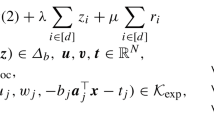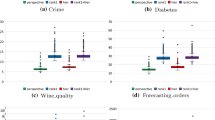Abstract
In this paper we review the relevant literature on mathematical optimization with logical implications, i.e., where constraints can be either active or disabled depending on logical conditions to hold. In the case of convex functions, the theory of disjunctive programming allows one to formulate these logical implications as convex nonlinear programming problems in a space of variables lifted with respect to its original dimension. We concentrate on the attempt of avoiding the issue of dealing with large NLPs. In particular, we review some existing results that allow to work in the original space of variables for two relevant special cases where the disjunctions corresponding to the logical implications have two terms. Then, we significantly extend these special cases in two different directions, one involving more general convex sets and the other with disjunctions involving three terms. Computational experiments comparing disjunctive programming formulations in the original space of variables with straightforward bigM ones show that the former are computationally viable and promising.


Similar content being viewed by others
References
Adams, J., Balas, E., Zawack, D.: The shifting bottleneck procedure for job shop scheduling. Manag. Sci. 34, 391–401 (1983)
Aktürk, S., Atamtürk, A., Gürel, S.: A strong conic quadratic reformulation for machine-job assignment with controllable processing times. Technical Report BCOL Research Report 07.01, Industrial Engineering and Operations Research, University of California, Berkeley (2007)
Ascheuer, N.: Hamiltonian Path Problems in the On-line Optimization of Flexible Manufacturing Systems. PhD thesis, Technische Universität Berlin (1995)
Balas, E.: Disjunctive programming. Ann. Discrete Math. 5, 3–51 (1979)
Balas, E.: Disjunctive programming: properties of the convex hull of feasible points. Discrete Appl. Math. 89, 3–44 (1998)
Balas, E., Ceria, S., Cornuéjols, G.: A lift-and-project cutting plane algorithm for mixed 0–1 programs. Math. Program. 58, 259–324 (1993)
Balas, E., Ceria, S., Cornuéjols, G.: Mixed 0–1 programming by lift-and-project in a branch-and-cut framework. Manag. Sci. 42, 1229–1246 (1996)
Balas, E., Jeroslow, R.: Strengthening cuts for mixed integer programs. Eur. J. Oper. Res. 4, 224–234 (1980)
Belotti, P., Bonami, P., Fischetti, M., Lodi, A., Monaci, M., Nogales-Gómez, A., Salvagnin, D.: On handling indicator constraints in mixed-integer programming. Technical Report OR/13/1, revised OR/14/20, DEI, University of Bologna (2014)
Belotti, P., Liberti, L., Lodi, A., Nannicini, G., Tramontani, A.: Disjunctive inequalities: applications and extensions. In: Cochran, J.J. (ed.) Wiley Encyclopedia of Operations Research and Management Science, vol. 2, pp. 1441–1450. Wiley, New York (2011)
Ben-Ameur, W., Ouorou, A.: Mathematical models of the delay-constrained routing problem. Algorithmic Oper. Res. 1, 94–103 (2006)
Blażewicz, J., Pesch, E., Sterna, M.: The disjunctive graph machine representation of the job shop scheduling problem. Eur. J. Oper. Res. 127, 317–331 (2000)
Bonami, P.: Lift-and-project cuts for mixed integer convex programs. In: Günlük, O., Woeginger, G. (eds.) Integer Programming and Combinatorial Optimization, Volume 6655 of Lecture Notes in Computer Science, pp. 52–64. Springer, Berlin (2011)
Bonami, P.: On optimizing over lift-and-project closures. Math. Program. Comput. 4, 151–179 (2012)
Bonami, P., Linderoth, J.T., Lodi, A.: Disjunctive cuts for mixed integer nonlinear programming problems. In: Majoub, R. (ed.) Progress in Combinatorial Optimization, pp. 521–544. Wiley/ISTE, New York (2011)
Brooks, J.P.: Support vector machines with the ramp loss and the hard margin loss. Oper. Res. 59, 467–479 (2011)
Ceria, S., Soares, J.: Convex programming for disjunctive convex optimization. Math. Program. 86, 595–614 (1999)
Conjunctive Normal Form. In: Hazewinkel, M. (ed.) Encyclopedia of Mathematics. Springer, Berlin (2001)
Cornuéjols, G., Fisher, M.L., Nemhauser, G.L.: Location of bank accounts to optimize float: an analytic study of exact and approximate algorithms. Manag. Sci. 23, 789–810 (1977)
Dash, S., Günlük, O., Lodi, A., Tramontani, A.: A time bucket formulation for the traveling salesman problem with time windows. INFORMS J. Comput. 24, 132–147 (2012)
Elhedhli, S.: Service system design with immobile servers, stochastic demand, and congestion. Manuf. Serv. Oper. Manag. 8, 92–97 (2006)
Fischetti, M., Lodi, A., Tramontani, A.: On the separation of disjunctive cuts. Math. Program. 128, 205–230 (2011)
Fisher, H., Thompson, G.L.: Probabilistic learning combinations of local job-shop scheduling rules. In: Muth, J.F., Thompson, G.L. (eds.) Industrial Scheduling, pp. 225–251. Prentice-Hall, Englewood Cliffs (1963)
Frangioni, A., Gentile, C.: Perspective cuts for a class of convex 0–1 mixed integer programs. Math. Program. 106, 225–236 (2006)
Furman, K., Grossmann, I.E., Sawaya, N.: A useful algebraic representation of disjunctive convex sets using the perspective function. In: Conference talk MINLP, Pittsburgh (2014)
Grossmann, I.E., Lee, S.: Generalized convex disjunctive programming: nonlinear convex hull relaxation. Comput. Optim. Appl. 26, 83–100 (2003)
Grossmann, I.E., Trespalacios, F.: Systematic modeling of discrete–continuous optimization models through generalized disjunctive programming. AIChE J. 59(9), 3276–3295 (2013)
Günlük, O., Lee, J., Weismantel, R.: MINLP strengthening for separaable convex quadratic transportation-cost UFL. Technical Report RC24213 (W0703–042), IBM Research Division (2007)
Günlük, O., Linderoth, J.: Perspective reformulation and applications. In: Lee, J., Leyffer, S. (eds.) Mixed Integer Nonlinear Programming, Volume 154 of The IMA Volumes in Mathematics and its Applications, pp. 61–89. Springer, New York (2012)
Hijazi, H.: Mixed-Integer Nonlinear Optimization Approaches for Network Design in Telecommunications. PhD thesis, Université d’Aix-Marseille II (2010)
Hijazi, H., Bonami, P., Cornuéjols, G., Ouorou, A.: Mixed integer nonlinear programs featuring “on/off” constraints. Comput. Optim. Appl. 52, 537–558 (2012)
Hijazi, H., Liberti, L.: Constraint qualification failure in second-order cone formulations of unbounded disjunctions. Technical Report, NICTA, Canberra ACT Australia (2014)
Jeroslow, R., Lowe, J.: Modelling with integer varibales. In: Korte, B., Ritter, K. (eds.) Mathematical Programming at Oberwolfach II, Volume 22 of Mathematical Programming Studies, pp. 167–184. Springer, Berlin (1984)
Kılınç, M.: Disjunctive Cutting Planes and Algorithms for Convex Mixed Integer Nonlinear Programming. PhD thesis, University of Wisconsin-Madison (2011)
Kılınç, M., Linderoth, J., Luedtke, J.: Effective separation of disjunctive cuts for convex mixed integer nonlinear programs. Technical Report TR1681, Computer Sciences Department, University of Wisconsin-Madison (2010)
Koch, T., Achterberg, T., Andersen, E., Bastert, O., Berthold, T., Bixby, R.E., Danna, E., Gamrath, G., Gleixner, A.M., Heinz, S., Lodi, A., Mittelmann, H., Ralphs, T., Salvagnin, D., Steffy, D.E., Wolter, K.: Miplib 2010. Math. Program. Comput. 3, 103–163 (2011)
Koch, T., Hiller, B., Pfetsch, M.E., Schewe, L. (eds.): Evaluating Gas Network Capacities. SIAM-MOS series on Optimization. SIAM, Philadelphia (2014)
Lawrence, S.: Resource Constrained Project Scheduling: An Experimental Investigation of Heuristic Scheduling Techniques. GSIA, Carnegie Mellon University, Pittsburgh (1984)
Lee, S., Grossmann, I.E.: New algorithms for nonlinear generalized disjunctive programming. Comput. Chem. Eng. 24, 2125–2141 (2000)
Lodi, A.: Indicator constraints in mixed-integer programming. In: Conference Talk MIP, Columbus (2014)
Lodi, A.: Mixed integer programming computation. In: Jünger, M., Liebling, T.M., Naddef, D., Nemhauser, G.L., Pulleyblank, W.R., Reinelt, G., Rinaldi, G., Wolsey, L.A. (eds.) 50 Years of Integer Programming 1958–2008, pp. 619–645. Springer, Berlin (2010)
Stubbs, R.A., Mehrotra, S.: A branch-and-cut method for 0–1 mixed convex programming. Math. Program. 86, 515–532 (1999)
Tramontani, A.: Lift-and-project cuts in CPLEX 12.5.1. In: Conference Talk INFORMS, Minneapolis (2013)
Acknowledgments
The second author acknowledges the support of MIUR, Italy, under the grant PRIN 2012. The fourth author acknowledges the support of the EU ITN 316647 “Mixed-Integer Nonlinear Optimization” (MINO). We are indebted to four anonymous referees for a careful reading and insightful suggestions.
Author information
Authors and Affiliations
Corresponding author
Rights and permissions
About this article
Cite this article
Bonami, P., Lodi, A., Tramontani, A. et al. On mathematical programming with indicator constraints. Math. Program. 151, 191–223 (2015). https://doi.org/10.1007/s10107-015-0891-4
Received:
Accepted:
Published:
Issue Date:
DOI: https://doi.org/10.1007/s10107-015-0891-4




